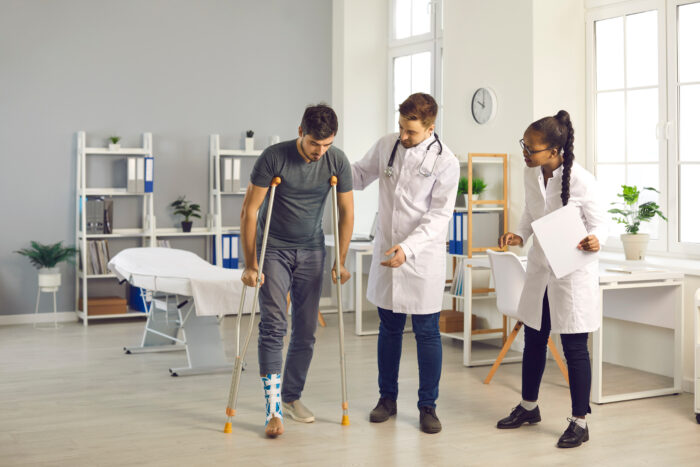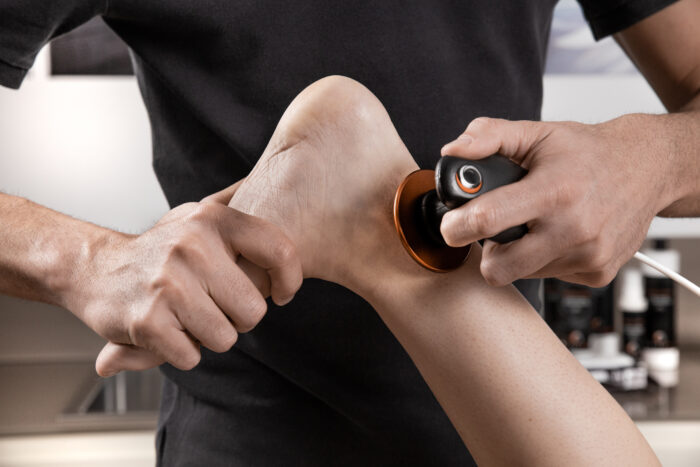Injuries related to ankle sprain are common and often, if neglected or not treated with the correct therapeutic approach, can generate long-term repercussions especially for those who practice sports.
In this article we start from a brief epidemiological and etiological analysis to arrive at a hypothesis of treatment through instrumental physical therapy (Tecar T-Plus device).
As it happens for almost all epidemiological analysis of injures, the statistical numbers about the ankle joints vary according to the sources referred to.
Here we have considered 5 cases of which we summarize here the main findings.
At epidemiological level:
- 16% of sports injuries involve the ankle area (1).
- 84% of ankle injuries are sprained (1).
- The right ankle is more commonly injured (58%) than the left one (42%) (3).
- The higher prevalence of cases of ankle sprain is recorded between the ages of 10 and 19 (4).
- Males between the ages of 15 and 24 have higher rates of ankle sprains than their female counterparts (4).
- Women over the age of 35 have higher rates of ankle sprains than their male counterparts (4).
- About half of all ankle sprains occur during sports (4).

In an epidemiological investigation of ankle sprain conducted in Hong Kong (5):
- 73% of all athletes had a recurrent ankle sprain
- 59% of these athletes had significant disability and residual symptoms leading to impaired athletic performance.

Regarding ankle fractures (2):
- Under the age of 50, ankle fractures are more common in men. Over the age of 50 it is more common in women.
- Overall incidence of 107 fractures per million per year (in a one-year study).
- The main cause of the fracture is falling (87%) to the ground, star or from above.
- 55% from sporting, recreational or recreational activities.
- Almost 1/3 of the cases were caused by slippery surfaces or were in a state of intoxication.
- Almost half of the patients are hospitalized after the injury.
From a first analysis it could be said that instability, demographic and environmental factors contribute to increasing the risk of ankle injury.
Only 55% of distortions originate from sporting or recreational events. This means that a good part of them occur in circumstances in which even those who do not practice sport regularly can be found.
In the professional field, the very high percentage of athletes who once suffered the injury find it difficult to fully recover their previous athletic performance and who almost all get injured recurrently. We can add that in 90% of cases the distortion is of the lateral type with damage of the first or second degree (rarely of the third degree) while the rest of the cases are of the medial type. For this second category, the rehabilitation course is typically more complicated.
The rehabilitation process of post-injury ankle sprain plays a fundamental role in determining any post-traumatic repercussions and recovery times are fundamental. Shorter recovery time is typically related to a lower risk of long-term repercussions.
Which remedies can be used for a therapeutic approach to ankle sprain?

Very often we limit ourselves to putting ice, lifting the limb and compressing the area to limit the onset of widespread edema, but this represents a relatively limited approach that can give benefits only in the first hours after the injury and above all there may be side effects. effects in prolonged use of the cold. Recent studies have in fact shown that excessive use of ice can reduce the ability of lymphatic capillaries to reabsorb edema and, at the same time, generates vasoconstriction phenomena that can limit the supply of nutrition to the tissues that need to be repaired.
The timing with which the various therapeutic actions are carried out is also another fundamental element to take into consideration. In a 2017 meta-analysis of treatments useful in case of ankle sprain Cailbhe Doherty et al. showed strong evidence that early mobilization is one of the most important factors in rehabilitation.
One of the obstacles to early mobilization is the pain and joint limitation that are often associated with ankle sprain in the first few days after trauma.

The basic steps are therefore: keeping the inflammatory reaction under control, limiting the accumulation of edema and circulatory stasis, promoting micro-circulation and regeneration of functional tissue and promoting early controlled exercise.
How can we resolve an ankle sprain with a therapeutic approach that includes Tecar T-Plus?
The action maneuver is often limited by the possibility of applying physical therapy tools in the early stages as these often tend to generate thermal increases that are contraindicated in the acute phases of injuries.
T-Plus is an operator dependent tecar device that allows you to reduce the volume of edema and pain already in the acute phase of the injury. This feature allows the therapist to be able to mobilize the joint early without pain. In the most advanced phase of the injury, it is also possible to act on the visco-elasticity of the tissue to further promote the improvement of the joint range.


The medical device is of fundamental use in all post-injury rehabilitation phases, allowing the operator to choose precisely the quantities of energy to be transferred to the tissue in the different phases of the rehabilitation program: from a few joules per second in the most acute phase up to tens. of KiloJoule in a session of a few minutes with practically nullified surface thermal effects.
An example of a treatment for ankle sprain with a therapeutic approach that combines tecar and manual therapy
A typical application program for an ankle sprain consists of 3 to 6 sessions.
Here is an example of treatment for the first session:
- Phase 1: Proximal vasodilation at the level of twins with hyperthermic capacitive without conductive cream. 300 VA for 5 ‘.
- Phase 2: Drainage on the portion of tissue affected by edema with a hypothermic capacitive electrode at 20VA for 15 minutes

Starting from the third session, but once the edema and pain have been significantly reduced, the treatment evolves according to the new needs of the tissue by introducing a phase dedicated to tissue regeneration through a resistive electrode applying a precise amount of energy to promote the stimulus without increasing the temperature of the fabric.
Methods and area of application have a significant impact on the outcome of the treatment.
1 – Fong, D. T., Hong, Y., Chan, L., Yung, P. S., & Chan, K. (2007). A Systematic Review on Ankle Injury and Ankle Sprain in Sports. Sports Medicine, Volume 37, 73-94.
2 – Jensen, S. J., Andresen, B. K., Mencke, S., & Nielsen, P. T. (2009). Epidemiology of ankle fractures: A prospective population-based study of 212 cases in Aalborg, Denmark. Acta Orthopaedica Scandinavica, Volume 69, 48-50.
3 – Luciano, A. P., & Lara, L. C. R. (2012). Epidemiological study of foot and ankle injuries in recreational sports. Acta Ortopédica Brasileira, Volume 20(6), 339-342.
4 – Waterman, B. R., Owens, B. D., Davey, S., Zacchilli, M. A., & Belmont, P. J. Jr. (2010). The epidemiology of ankle sprains in the United States. The Journal of Bone and Joint Surgery. American Volume, Volume 92 (13), 2279-84
5 – Yeung, M. S., Chan, K., So, C. H., & Yuan, W. Y. (1994). British Journal of Sports Medicine, 28 (2), 112–116.
DISCLAIMER
Our sections dedicated to the rehabilitation of pathological states aim to share with doctors, physiotherapists and health professionals, for informational purposes, the scientific rationale of the treatments that can be implemented through the medical technologies we develop, giving food for thought useful for understanding the cause / effect relationship of our tools.
The contents of these articles are the result of the scientific research that we directly promote, the analysis of the available bibliography and the synthesis of clinical data provided by the specialists in our network.
Any useful information that you can find in these pages must NEVER replace an in-depth clinical analysis compatible with the degree of severity of the pathology you are facing for your patient and must NOT be understood as a substitute for the doctor’s opinion.
WINTECARE cannot be held responsible for adverse events resulting from the improper use of the information contained in these pages.
Riquadri laterali




